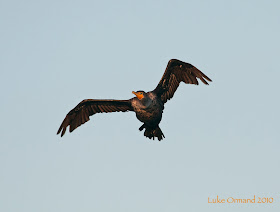Between the weather, work and the prospect of moving this week I haven't been able to get out and create any new images, so we are diving back into the archives. Enjoy. (Above/Below: Barn Swallow)
A Brown Thrasher was a few dozen feet away:
The end of June brought these images of a Belted Kingfisher and Great Egret at Weesuck Creek in East Quogue:
A meal the Kingfisher above would have loved to have gotten:
Mornings can often coincide with large numbers of egrets feeding along Dune Rd. in the marshlands after a long nights sleep. Here is a Snowy that was quite difficult to properly expose but I'm thrilled the bill stands out against the dark background.
And lastly here is a Double Crested Cormorant in flight - which is not an easy task. Taken at the Shinnecock Inlet.
Pages
▼
Wednesday, August 25, 2010
Saturday, August 14, 2010
End of the Doldrums
As we make our way through August, shorebirds are finding their way down south and things are picking up. I set out to Cupsogue this morning in search of Marbled Godwits which have been reported but didn't find them. I did, however, find a slew of other fun to photo species (Above/Below: Black Skimmer)
I had an awesome experience with some sharp-tailed sparrows (I believe these are the "saltmarsh" variety). This species of Sparrow is very shy and I'd only seen it on one previous occasion but they put on a nice show this morning.
A habitat shot just as the sun was rising:
A Roseate Tern made a surprise fly by which I didn't realize until after I got home and looked at the files. There's a good chance this breeding adult is from one of the two colonies about 2 miles to the West where I had done Tern restoration work in conjunction with the State and Federal Government.
Edit: After speaking with John Turner, it has been pointed out that this is almost certainly a Common Tern and not a Roseate - based mostly on the short tail as opposed to the Roseate's deeply forked tail. What through me off was the bill coloration as Roseate's do get a black/red bill, but generally they are more black than this, so with that, thank you John for setting me straight (as usual).
And later on, another Roseate (possibly the same one) made a surprise appearance with a meal in its mouth:
As long as we are on the topic of Terns, here are some shots of a Common Tern:
Above: Adult. Below: Juvenile.
I'll round things out with 2 species that are a bit more commonly seen, the Double-Crested Cormorant and the Osprey.
Here is an adult Osprey with a fish (a juvenile is also in the nest)
I had an awesome experience with some sharp-tailed sparrows (I believe these are the "saltmarsh" variety). This species of Sparrow is very shy and I'd only seen it on one previous occasion but they put on a nice show this morning.
A habitat shot just as the sun was rising:
A Roseate Tern made a surprise fly by which I didn't realize until after I got home and looked at the files. There's a good chance this breeding adult is from one of the two colonies about 2 miles to the West where I had done Tern restoration work in conjunction with the State and Federal Government.
Edit: After speaking with John Turner, it has been pointed out that this is almost certainly a Common Tern and not a Roseate - based mostly on the short tail as opposed to the Roseate's deeply forked tail. What through me off was the bill coloration as Roseate's do get a black/red bill, but generally they are more black than this, so with that, thank you John for setting me straight (as usual).
And later on, another Roseate (possibly the same one) made a surprise appearance with a meal in its mouth:
As long as we are on the topic of Terns, here are some shots of a Common Tern:
Above: Adult. Below: Juvenile.
I'll round things out with 2 species that are a bit more commonly seen, the Double-Crested Cormorant and the Osprey.
Here is an adult Osprey with a fish (a juvenile is also in the nest)
Sunday, August 8, 2010
Gyrfalcon and other oldies
Well considering it's been 3 weeks since I last made an update to my blog, you can guess that summertime is slow time when it comes to birds. I've been off photographing rare flowers, toads and turtles (all of which can be seen on my sister blog: www.WildLongIsland.blogspot.com). So in light of the lack of feathered subjects, I'm going to post some archival images for your viewing pleasure. The theme here (incase you can't tell) is flight. (Above/Below: Gyrfalcon from October, 2009)
Some Common Terns from "Tern Island":
A Black Crowned Night Heron made its way back to its roost a few months ago along Dune Rd. at sunset:
In April, this Osprey successfully harassed some gulls for a crab legs snack:
Recently, a Juvenile Osprey tested out its wings at Cupsogue County Park:
A few minutes later I was photographing this Black Skimmer that gracefully cut the water in search of food:
Lastly, November provided this Mallard gem... if only I hadn't clipped the wings.

























.jpg)